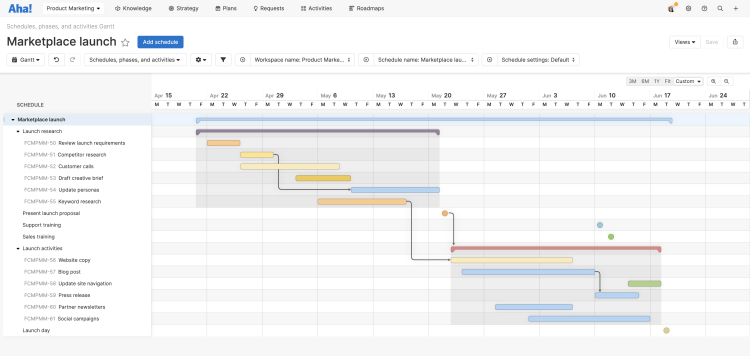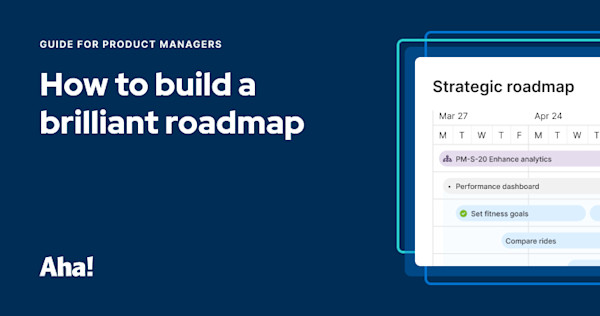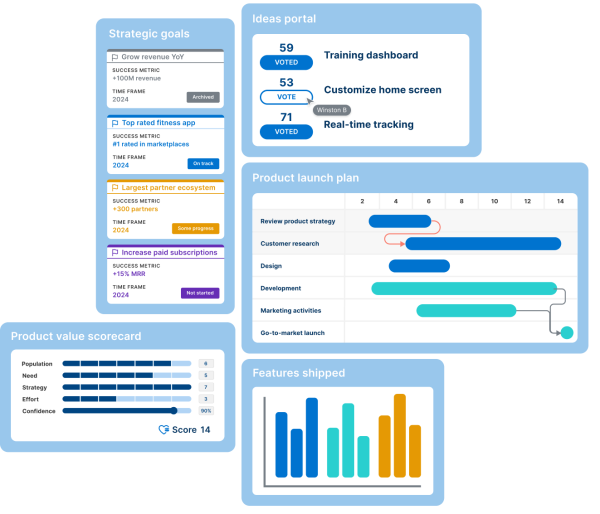PI planning vs. release planning
Last updated: September 2024
Your day, your week, your month ... even your year. 🎶 Product teams are always planning something — from long-term strategy to the next product launch and all that happens in between. With so much going on at once, sometimes plans get muddled. This is especially true when multiple plans seem to overlap.
PI plans and release plans are examples of this. On the surface, they appear similar. Both involve cross-functional product development teams planning to deliver large bodies of work. Both happen within set short-term time frames. And if you are a product manager at an enterprise organization, you might be involved in both types of plans.
But there are a number of key differences that define PI planning and release planning, including the role product managers play in each. It is important to understand these nuances so you can be confident in contributing to both planning types.
Set winning plans with Aha! software — free for 30 days.
This guide will help you learn what you need to know about PI planning versus release planning (plus, how real teams manage each using product development software). Let's dive in:
Let's start with some definitions
What is PI planning?
PI planning is a structured, recurring event for coordinating software development across multiple agile teams. It is designed to help large organizations come together and create a plan for upcoming work — guided by established practices and roles. It is a key ceremony for organizations that follow the Scaled Agile Framework® (SAFe®), but many others choose to simply borrow PI planning (or a version of it) as well.
A PI plan comprises objectives for the next planning interval (PI) and multiple teams' sprint plans for the next eight to 12 weeks. (Note that in SAFe and PI planning, a group of agile teams is referred to as an agile release train, or ART). During PI planning sessions, the ART and other stakeholders work to define and agree on the PI plan.
Some find PI planning to be bureaucratic and burdensome. It is a lot to coordinate in a couple of days, which can leave people feeling overwhelmed or bound by the rigidity of the practice. But many major organizations rely on this added layer of structure to help organize work across hundreds of engineers. (Hint: For those who experience PI planning frustration, the right teamwork and tools can help).

An example of a PI plan drafted on a program board in Aha! Whiteboards
Related:
What is release planning?
Release planning is the process of preparing to launch a new offering or customer experience by a target date. The idea is to consider all the work required to deliver these new enhancements — from marketing efforts to support documentation and sales training — and map it out on a detailed timeline. Release planning is not tied to a specific methodology and is done by product development teams of all types and sizes.
A release plan typically includes phases or themes of work, features to be delivered, key dates and milestones, dependencies, and progress indicators. (Note that the release itself refers to the whole body of work you intend to deliver and when. You might also call it a launch.) Many product teams operate on a regular weekly, monthly, or quarterly release cadence. Planning kicks off at the start of a new release, and there are ongoing adjustments as work gets underway.
Some agile product managers think of the term "release planning" to be obsolete; they are in favor of continuous delivery and more flexible timelines. But this type of approach focuses more narrowly on development work and is not a replacement for release planning. It is still essential to consider how you will share the new offering with customers and involve the broader organization in doing so.

An example of a Gantt-style release plan with phases and milestones created in Aha! Roadmaps
Related:
Now, what are the differences between PI planning and release planning?
As we mentioned earlier, PI planning and release planning are alike in a general sense. Both involve agile product teams, cross-functional collaboration, and near-term plans. And both share the broad goal of delivering incremental value to customers and the business.
The differences become clearer when you dig into what is actually being planned and who is doing the planning. Here are a few critical things that set the two types of plans apart:
Scope of work
PI planning is all about engineering work. Although other stakeholders might have input on priorities, the goal is to plan development tasks for the next several weeks.
Release planning is more cross-functional. The scope often includes work across product management, marketing, engineering, operations, and more. If you do both types of planning on your team, that means the PI plan might actually fall under the broader release plan — the functionality you build is just one piece of the overall experience you provide.
'How' vs. 'when'
PI planning emphasizes how agile teams will achieve PI objectives over the course of multiple sprints by communicating priorities, estimating capacity, and aligning the ART around the work to be done.
Release planning focuses more on when the enhancements will be ready to deliver. It factors in all the cross-team efforts, potential roadblocks, and milestones along the way.
Product manager's role
PI planning is an event where product managers play an important (but supporting) role. You ensure the backlog is prioritized and ready to go, you present the product vision in the early sessions, and you help everyone keep product goals top of mind through the entire process. The agile development teams within the ART do the bulk of the actual planning (after all, it is their work that makes up the PI plan).
Release planning is a core product management responsibility. You lead the launch effort by defining which features to build and the overall implementation timeline (often in the form of a release roadmap or Gantt chart). You also create a repeatable standardized process for planning releases. All of this work incorporates input and effort from other teams, but you are at the helm.
The following table breaks down some additional differences between PI planning and release planning, offering a closer look at the specifics:
PI planning | Release planning | |
Purpose | To align on shared objectives and agile development plans for the upcoming PI | To define the cross-functional work required to deliver product enhancements to customers by a target launch date |
Timing | Every eight to 12 weeks at the start of each new PI | Based on release cadence (e.g., weekly, monthly, quarterly) or estimated time for work to be complete |
Roles involved |
|
|
Key activities |
|
|
Key artifacts |
| |
Best suited for |
|
|
Need examples? Explore PI planning and release planning in Aha! software.
It always helps to see things in action. You can create both PI plans and release plans in Aha! software. Check out the resources below to see real examples of what this looks like. (Even if you do not use our software, this can help you get more context on how product teams manage the details of these planning processes — from whiteboarding priorities to building roadmaps and moving work through development.)


